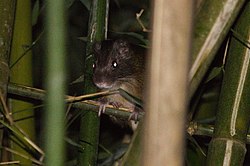Biology:Atlantic bamboo rat
| Atlantic bamboo rat Temporal range: Pleistocene to Recent
| |
|---|---|

| |
| Scientific classification | |
| Domain: | Eukaryota |
| Kingdom: | Animalia |
| Phylum: | Chordata |
| Class: | Mammalia |
| Order: | Rodentia |
| Family: | Echimyidae |
| Subfamily: | Echimyinae |
| Tribe: | Echimyini |
| Genus: | Kannabateomys Jentink, 1891 |
| Species: | K. amblyonyx
|
| Binomial name | |
| Kannabateomys amblyonyx Wagner, 1845
| |
| Subspecies | |
|
K. a. amblyonyx Wagner, 1845 | |
The Atlantic bamboo rat (Kannabateomys amblyonyx), or southern bamboo rat, is a spiny rat species found in humid tropical forests in Argentina , Brazil and Paraguay. It is the only member of the genus Kannabateomys.[2]
Description
The Atlantic bamboo rat can reach a head-and-body length of 25 cm (9.8 in) with a tail of 32 cm (12.6 in). Its weight is about 475 g (1 lb). The pelage is the typical agouti brown-to-grey colour of many rodents, grading to chestnut on the flanks. The chin and underparts are white tinged with reddish brown. The first 6 cm (2.4 in) of the tail are well-haired but the rest is sparsely haired. There is a distinct tuft of hairs at the tip. When fully grown, this bamboo rat with its long tail is unlikely to be mistaken for any other species.[3]
Etymology
The genus name Kannabateomys derives from the three ancient greek words κάννα (kánna), meaning "reed, cane", βατέω (batéō), meaning "to mount", and μῦς (mûs), meaning "mouse, rat".[4][5][6]
The species name amblyonyx derives from the two ancient greek words ἀμβλύς (amblús), meaning "blunt, not sharp", and ὄνυξ (ónux), meaning "claw, fingernail".[4][5]
Distribution and habitat
This species is native to South America, where its range includes southeastern Brazil, eastern Paraguay and northeastern Argentina. Typical habitat is moist forests near water with dense understorey of bamboos. It is particularly associated with the giant bamboo Guadua angustifolia, which forms thickets.[7]
Ecology
The Atlantic bamboo rat is nocturnal and is highly arboreal, scrambling around in trees and bamboos, especially near water. The home range is about 1,000 m2 (1,200 sq yd). When alarmed it issues loud squeals.[3] It probably feeds on grasses, leaves, shoots, fruits and tubers.[8]
Phylogeny
Kannabateomys is a member of the Echimyini clade of arboreal Echimyidae rodents. Its closest relatives are Dactylomys and Olallamys. These South American bamboo rats share unique features and are grouped under the informal clade name of "Dactylomyines".[9] The dactylomyines are the sister genera to Diplomys and Santamartamys. All these taxa are closely related to the genera Echimys, Phyllomys, Makalata, Pattonomys, and Toromys. In turn, these genera share phylogenetic affinities with the clade containing Lonchothrix and Mesomys, and with Isothrix.[10]
| Genus-level cladogram of the Echimyini. |
Status
K. amblyonyx is not a common species. In the state of Rio Grande do Sul in Brazil, for example, it has been recorded as having a density of just over four individuals per square kilometre. As a nocturnal animal it is seldom seen, but it has an extensive range and is presumed to have a large total population. In some places, such as in the state of Minas Gerais in Brazil, it is threatened locally by forest clearance, but other specific threats have not been identified and the International Union for Conservation of Nature has rated its conservation status as "least concern".[1]
References
- ↑ 1.0 1.1 Catzeflis, F.; Patton J.; Percequillo, A.; Weksler, M. (2016). "Kannabateomys amblyonyx". IUCN Red List of Threatened Species 2016: e.T10957A22205666. doi:10.2305/IUCN.UK.2016-2.RLTS.T10957A22205666.en. https://www.iucnredlist.org/species/10957/22205666. Retrieved 11 November 2021.
- ↑ Woods, C.A.; Kilpatrick, C.W. (2005). "Genus Kannabateomys". in Wilson, D.E.; Reeder, D.M. Mammal Species of the World: A Taxonomic and Geographic Reference (3rd ed.). Johns Hopkins University Press. p. 1576. ISBN 978-0-8018-8221-0. OCLC 62265494. http://www.departments.bucknell.edu/biology/resources/msw3/browse.asp?id=13400415.
- ↑ 3.0 3.1 Eisenberg, John F.; Redford, Kent H. (2000). Mammals of the Neotropics, Volume 3: Ecuador, Bolivia, Brazil. University of Chicago Press. p. 481. ISBN 978-0-226-19542-1. https://books.google.com/books?id=p2MDAzCeQQoC&pg=PA481.
- ↑ 4.0 4.1 Bailly, Anatole (1981-01-01). Abrégé du dictionnaire grec français. Paris: Hachette. ISBN 978-2010035289. OCLC 461974285.
- ↑ 5.0 5.1 Bailly, Anatole. "Greek-french dictionary online". http://www.tabularium.be/bailly/.
- ↑ Palmer, T. S. (1904) (in en). Details - Index generum mammalium: a list of the genera and families of mammals. - Biodiversity Heritage Library. Washington, Govt. Print. Off.. pp. 356. doi:10.5962/bhl.title.39809.
- ↑ Londoño, X. 2000. Guadua. In E. J. Judziewicz, R. J. Soreng, G. Davidse, P. M. Peterson, T. S. Filgueiras & F. O. Zuloaga (eds.) Catalogue of New World Grasses (Poaceae): I. Subfamilies Anomochlooideae, Bambusoideae, Ehrhartoideae, and Pharoideae, Contributions from the United States National Herbarium 39: 58–62. Smithsonian Institution, Washington
- ↑ Lord, Rexford D. (2007). Mammals of South America. JHU Press. p. 64. ISBN 978-0-8018-8494-8. https://books.google.com/books?id=iTt13fynOBIC&pg=PA64.
- ↑ Fabre, Pierre-Henri; Patton, James L.; Leite, Yuri L. R. (2016). "Family Echimyidae (hutias, South American spiny-rats and coypu)". Handbook of the Mammals of the World. Vol 6. Lagomorphs and Rodents I. Barcelona: Lynx Edicions. pp. 552–641. ISBN 978-84-941892-3-4.
- ↑ Fabre, Pierre-Henri; Upham, Nathan S.; Emmons, Louise H.; Justy, Fabienne; Leite, Yuri L. R.; Loss, Ana Carolina; Orlando, Ludovic; Tilak, Marie-Ka et al. (2017-03-01). "Mitogenomic Phylogeny, Diversification, and Biogeography of South American Spiny Rats". Molecular Biology and Evolution 34 (3): 613–633. doi:10.1093/molbev/msw261. ISSN 0737-4038. PMID 28025278.
Wikidata ☰ Q301578 entry
 |


